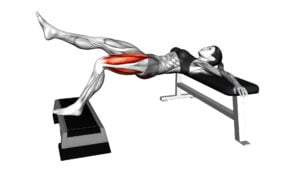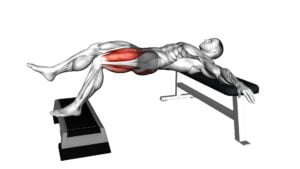Far Leg Hip Thrust (female) – Video Exercise Guide & Tips

Are you looking to tone and strengthen your lower body? Look no further than the Far Leg Hip Thrust.
Watch This Exercise Video
In this video exercise guide, we'll show you the proper set-up and positioning, step-by-step execution, and common mistakes to avoid.
With variations and progressions, you can customize your workout to fit your fitness level. Follow our tips to maximize your results and achieve your goals.
Get ready to feel the burn and sculpt those leg muscles!
Key Takeaways
- The Far Leg Hip Thrust targets and strengthens the glutes and hamstrings.
- It builds muscle and improves strength in the lower body.
- The exercise improves hip mobility and activates the glute muscles.
- It provides a well-rounded workout by targeting multiple muscle groups.
Benefits of the Far Leg Hip Thrust
Get the most out of your workout by incorporating the far leg hip thrust, a highly effective exercise for targeting and strengthening your glutes and hamstrings. This exercise not only helps to build muscle and improve strength, but it also has additional benefits for your hip mobility and glute activation.
Hip mobility is crucial for performing various movements and exercises, and the far leg hip thrust can help to improve it. By engaging your hip flexors and extensors, this exercise helps to increase the range of motion in your hips, allowing for better movement and flexibility in your lower body.
Additionally, the far leg hip thrust is a great exercise for activating and strengthening your glutes. As you thrust your hips upward, you're primarily targeting your glute muscles, forcing them to contract and work harder. This activation not only helps to build stronger glutes, but it can also improve your overall lower body strength and stability.
Incorporating the far leg hip thrust into your routine can provide you with a well-rounded workout that targets multiple muscle groups. By focusing on hip mobility and glute activation, you can enhance your overall performance and achieve better results in your fitness journey.
Proper Set-up and Positioning
To ensure proper execution of the far leg hip thrust, it's important to consistently and accurately position yourself. One common misconception about this exercise is that you need special equipment. However, all you really need is a sturdy bench or step, and your own body weight.
Begin by sitting on the bench or step with your knees bent and your feet flat on the ground. Your hands should be placed on the bench behind you for support. Next, extend one leg straight out in front of you, keeping it parallel to the ground. This will be your 'far leg' during the exercise.
Make sure your other leg is still bent with your foot planted firmly on the ground. This is your 'support leg.' By positioning yourself in this way, you'll be able to engage the proper muscles and perform the exercise correctly.
Once you have positioned yourself correctly, you can move on to the step-by-step execution of the exercise, which will be discussed in the next section.
Step-by-Step Execution of the Exercise
To execute the far leg hip thrust exercise, start by lying flat on your back with your knees bent and feet flat on the ground. Place one foot on a bench or step, ensuring that your knee is directly above your ankle.
Engage your glutes and drive your hips upward, lifting your body off the ground, and then lower back down with control.
Focus on maintaining a straight line from your shoulders to your knees throughout the movement.
Proper Form Tips
Maintain proper form during the far leg hip thrust exercise by engaging your glutes and hamstrings while keeping your core stable. To ensure you perform the exercise correctly, here are some tips to keep in mind:
- Common Misconceptions:
- Don't rely solely on your lower back to lift your leg. Instead, focus on using your glutes and hamstrings to initiate the movement.
- Avoid arching your back excessively, as this can put unnecessary strain on your spine. Keep your core engaged to maintain a neutral spine position.
- Modifications and Adaptations:
- If you're new to this exercise or have limited mobility, start by using a lower bench or step.
- For added challenge, you can place a resistance band around your thighs or hold a dumbbell on your hips.
Common Mistakes to Avoid
When performing the far leg hip thrust exercise, it's important to be aware of common mistakes that can hinder your progress and increase the risk of injury.
One common mistake isn't maintaining proper form throughout the movement. Avoid arching your back excessively or allowing your knees to cave in. It's crucial to keep your core engaged and your pelvis stable.
Another mistake is using too much momentum instead of relying on your glute muscles to perform the movement. Slow and controlled movements will yield better results.
Lastly, make sure to avoid lifting your hips too high, as this can strain your lower back.
Benefits of the Exercise
To maximize the benefits of the exercise, engage your glute muscles and maintain proper form throughout the step-by-step execution of the far leg hip thrust. This exercise offers several benefits that can help improve your overall fitness and strength.
Here are some of the key benefits and techniques of the far leg hip thrust:
- Activation of glute muscles: The far leg hip thrust targets the gluteus maximus, the largest muscle in your buttocks. This exercise helps to activate and strengthen these muscles, leading to improved muscle tone and definition.
- Improved hip stability: By performing the far leg hip thrust, you can enhance the stability of your hip joints. This is particularly beneficial for athletes involved in activities that require strong and stable hips, such as running, jumping, and squatting.
Transition: Now that you understand the benefits and techniques of the far leg hip thrust, it's important to be aware of common mistakes to avoid in order to ensure safe and effective execution of the exercise.
Common Mistakes to Avoid
To avoid common mistakes while performing the far leg hip thrust, make sure that you engage your core and maintain proper form throughout the exercise. One of the most common mistakes isn't engaging the core muscles enough. Your core plays a crucial role in stabilizing your body during the movement, so it's important to keep it tight and activated throughout.
Another common mistake is using excessive momentum to perform the exercise. This can lead to incorrect form and reduce the effectiveness of the exercise. To prevent this, focus on controlled movements and avoid using momentum to lift your leg.
Additionally, be mindful of your hip alignment. It's common to let your hips drop or rotate during the movement, which can place unnecessary strain on your lower back. Keep your hips level and stable throughout the exercise to maintain proper alignment.
By avoiding these common technique errors, you can ensure that you're getting the most out of your far leg hip thrusts and reducing the risk of injury.
Now, let's explore some variations and progressions of this exercise to continue challenging your glutes and further improve your strength and stability.
Variations and Progressions
To further challenge your glutes and improve strength and stability, explore various variations and progressions of the far leg hip thrust exercise. Here are some advanced modifications and resistance options you can try:
- Advanced Modifications:
- Single-Leg Far Leg Hip Thrust: Lift one leg off the ground and perform the exercise with only your supporting leg. This variation increases the demand on your glutes and challenges your balance.
- Weighted Far Leg Hip Thrust: Hold a dumbbell, kettlebell, or barbell across your hips to add resistance and increase the intensity of the exercise.
- Resistance Options:
- Resistance Band Far Leg Hip Thrust: Place a resistance band just above your knees and perform the exercise as usual. The band adds resistance throughout the movement, targeting your glutes even more.
- Barbell Far Leg Hip Thrust: Place a barbell across your hips and perform the exercise. This variation allows you to lift heavier weights and further strengthen your glutes.
By incorporating these advanced modifications and resistance options into your far leg hip thrust routine, you can continue to challenge your glutes and progress in your strength and stability.
Now, let's move on to the next section to learn some tips for maximizing your results.
Tips for Maximizing Results
To maximize your results and continue challenging your glutes and improving strength and stability, incorporate these tips into your far leg hip thrust routine.
- Focus on maintaining proper form throughout the exercise. Keep your core engaged and your back straight to target the glutes effectively.
- Make sure to use a weight that's challenging enough to stimulate muscle growth but still allows you to perform the exercise with proper technique. Gradually increase the weight as you get stronger to continue maximizing gains.
- Vary your foot placement. By experimenting with different positions, such as wide stance or narrow stance, you can target different areas of the glutes and achieve a more well-rounded workout.
- Don't forget to squeeze your glutes at the top of the movement for an extra burn.
- Consider incorporating supersets or drop sets into your routine to increase intensity and challenge your muscles even further.
Frequently Asked Questions
How Many Sets and Repetitions Should I Do When Performing the Far Leg Hip Thrust?
To get the most out of the far leg hip thrust, it's essential to consider the number of sets and repetitions. When performing this exercise, aim for around 3 to 4 sets with 10 to 12 repetitions per set.
This will help build strength and target the muscles effectively. However, remember that proper form is crucial for optimal results and to prevent injury.
Keep your core engaged and maintain a controlled motion throughout the exercise.
Can the Far Leg Hip Thrust Be Performed by Individuals With Lower Back Issues?
If you have lower back issues, it's important to be cautious when performing the Far Leg Hip Thrust. It may not be the best exercise for you. However, there are modified hip thrust variations that can be done to avoid aggravating your lower back problems.
Additionally, there are alternative exercises that can help strengthen your glutes without putting stress on your lower back. It's always a good idea to consult with a fitness professional or physical therapist for personalized recommendations.
Is It Necessary to Use Weights or Resistance When Doing the Far Leg Hip Thrust?
To answer your question, it isn't necessary to use weights or resistance when doing the far leg hip thrust. This exercise primarily targets your glutes, hamstrings, and core muscles.
However, adding weights or resistance can increase the intensity and provide additional benefits. You can also try different variations of the exercise, such as using a stability ball or performing single leg hip thrusts, to further challenge your muscles and add variety to your workout routine.
How Long Does It Typically Take to See Results From Incorporating the Far Leg Hip Thrust Into My Workout Routine?
Incorporating the far leg hip thrust into your workout routine can yield results in a relatively short amount of time. The expected results will vary depending on factors such as your current fitness level and consistency in performing the exercise.
However, with regular practice, you can expect to see improvements in your glute strength and overall lower body stability.
For beginners, it's important to start with proper form and gradually increase the intensity by adding resistance or weights.
Are There Any Specific Warm-Up Exercises or Stretches That Should Be Done Prior to Performing the Far Leg Hip Thrust?
To properly prepare for the far leg hip thrust, it's important to do some warm-up exercises and stretches. This will help activate the muscles and increase flexibility, reducing the risk of injury.
Prior to performing the exercise, try incorporating dynamic stretches like leg swings or hip circles to warm up the hips and lower body.
Additionally, consider doing glute activation exercises like bridges or clams to engage the muscles specifically targeted in the hip thrust.
Conclusion
In conclusion, the far leg hip thrust is a beneficial exercise for females looking to strengthen their lower body and improve hip mobility. By following proper set-up and positioning, executing the exercise correctly, and avoiding common mistakes, one can maximize their results.
Additionally, incorporating variations and progressions can add challenge and variety to the workout. Remember to use these tips and techniques to get the most out of your far leg hip thrust routine.

Author
Years ago, the spark of my life’s passion ignited in my mind the moment I stepped into the local gym for the first time. The inaugural bead of perspiration, the initial endeavor, the very first surge of endorphins, and a sense of pride that washed over me post-workout marked the beginning of my deep-seated interest in strength sports, fitness, and sports nutrition. This very curiosity blossomed rapidly into a profound fascination, propelling me to earn a Master’s degree in Physical Education from the Academy of Physical Education in Krakow, followed by a Sports Manager diploma from the Jagiellonian University. My journey of growth led me to gain more specialized qualifications, such as being a certified personal trainer with a focus on sports dietetics, a lifeguard, and an instructor for wellness and corrective gymnastics. Theoretical knowledge paired seamlessly with practical experience, reinforcing my belief that the transformation of individuals under my guidance was also a reflection of my personal growth. This belief holds true even today. Each day, I strive to push the boundaries and explore new realms. These realms gently elevate me to greater heights. The unique combination of passion for my field and the continuous quest for growth fuels my drive to break new ground.



